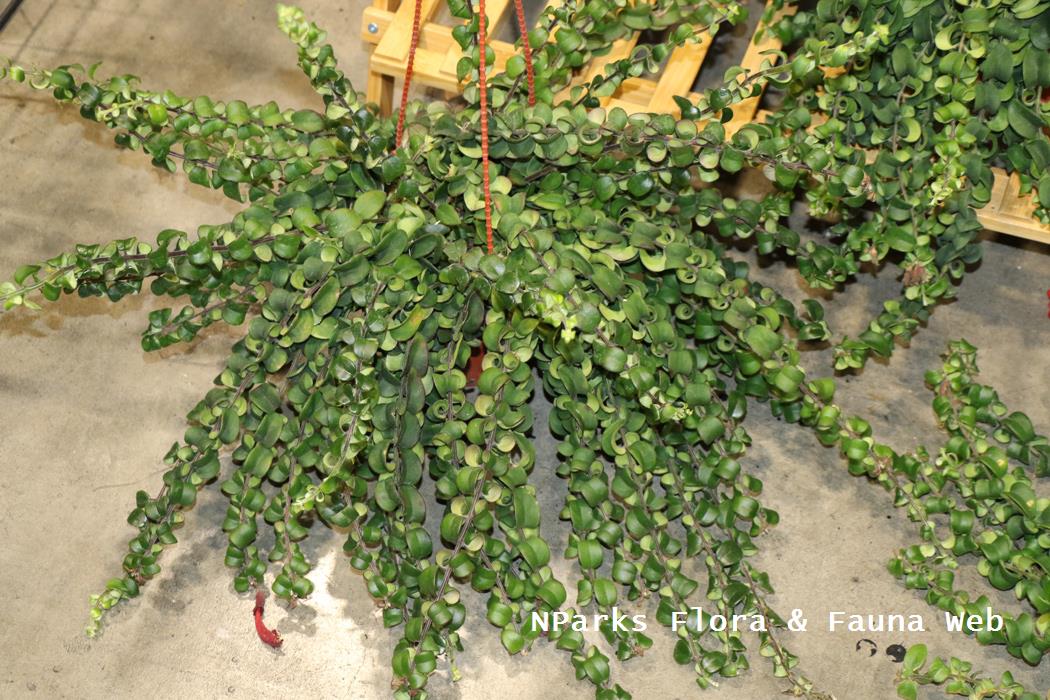
Back
Aeschynanthus pulcher (curly leaf)
| Family Name: | Gesneriaceae |
| Synonyms: | Aeschynanthus lobbianus (curly leaf) |
| Common Name: | Lipstick Plant, 口红花 |
A curly form of Aeschynanthus pulcher, this epiphyte is a great addition to any indoor garden, parks and gardens for its bright red tubular flowers and curled leaves.
Name
Classifications and Characteristics
| Plant Division | Angiosperms (Flowering Seed Plants) (Dicotyledon) |
|---|---|
| Plant Growth Form | Shrub, Epiphyte |
| Lifespan (in Singapore) | Perennial |
| Mode of Nutrition | Autotrophic |
| Maximum Height | 0.5 m to 1 m |
| Maximum Plant Spread / Crown Width | 0.1 m to 0.5 m |
Biogeography
| Native Distribution | Of horticultural origin. |
|---|---|
| Native Habitat | Terrestrial |
| Preferred Climate Zone | Tropical |
| Local Conservation Status | Non-native (Horticultural / Cultivated Only) |
Description and Ethnobotany
| Growth Form | Herb with trailing growth habit. |
|---|---|
| Foliage | Thick, fleshy leaves are elliptic and tightly curled under. They occur in decussate leaf arrangement with adjacent leaf pairs perpendicular to one another. The upper surface is smooth and dark green with a prominent sunken midrib, while the lower surface is light green. |
| Stems | Dark purple to green, sparsely hairy to smooth. |
| Flowers | Bright red, tubular flower has 3-4 triangular lobes. The calyx (outermost layer of the flower composed of the sepals) is reddish brown and tubular. It is densely covered in short, white hairs and has triangular lobes near the opening. |
| Fruit | Not seen in the wild. |
| Cultivation | Grow in soil mix with good drainage and aeration, and plant best grown under semi-shade or bright filtered light condition. Allow top portion of media (about 1 quarter of the pot) to dry before watering. Stems can be pruned to promote bushiness and create more blooms. The cuttings can be used for propagation. Place the cut end of the stem into the moist soil, and place pot in a warm location where it receives bright, indirect sunlight. |
| Etymology | The genus Aeschynanthus is from the Greek words aischune meaning shame and anthos meaning flower referring to the red flowers. The species epithet pulcher means beautiful. |
Landscaping Features
| Landscaping | Commonly cultivated in hanging baskets for it's attractive lipstick-like clusters of flowers and curly leaves. |
|---|---|
| Desirable Plant Features | Ornamental Foliage, Ornamental Flowers |
| Landscape Uses | Suitable for Hanging Baskets, Interiorscape/ Indoor Plant |
Fauna, Pollination and Dispersal
| Fauna Pollination Dispersal Associated Fauna | Bird-Attracting (Flowers) |
|---|---|
| Pollination Method(s) | Biotic (Fauna) (Vertebrates (Bird)) |
Plant Care and Propagation
| Light Preference | Semi-Shade |
|---|---|
| Water Preference | Moderate Water |
| Plant Growth Rate | Fast to Moderate |
| Rootzone Tolerance | Well-Drained Soils |
| Propagation Method | Stem Cutting |
Foliar
| Foliage Retention | Evergreen |
|---|---|
| Mature Foliage Colour(s) | Green |
| Mature Foliage Texture(s) | Thick |
| Prominent Young Flush Colour(s) | Green |
| Young Flush Texture(s) | Thick |
| Foliar Type | Simple / Unifoliate |
| Foliar Arrangement Along Stem | |
| Foliar Attachment to Stem | Petiolate |
| Foliar Shape(s) | Non-Palm Foliage (Elliptical) |
| Foliar Venation | Pinnate / Net |
| Foliar Margin | Entire |
| Foliar Apex - Tip | Acute, Rounded |
| Foliar Base | Acute |
Non - Foliar and Storage
| Stem Type & Modification | Woody |
|---|---|
| Root Type | Underground |
Floral (Angiosperm)
| Flower & Plant Sexuality | Bisexual Flowers |
| Flower Colour(s) | Red |
|---|---|
| Flower Texture(s) | Smooth |
| Flower Grouping | Cluster / Inflorescence |
| Flower Location | Terminal |
| Flower Symmetry | Bilateral |
| Individual Flower Shape | Tubular |
| Inflorescence Type | Umbel |
| Flowering Period | Free-Flowering |
| Flowering Habit | Polycarpic |
Fruit, Seed and Spore
| Fruit Classification | Simple Fruit |
|---|---|
| Fruit Type | Dehiscent Dry Fruit , Capsule |
| Seed Description | Grain, papillose. |
Image Repository
Others
| Master ID | 3 |
|---|---|
| Species ID | 1299 |
| Flora Disclaimer | The information in this website has been compiled from reliable sources, such as reference works on medicinal plants. It is not a substitute for medical advice or treatment and NParks does not purport to provide any medical advice. Readers should always consult his/her physician before using or consuming a plant for medicinal purposes. |







